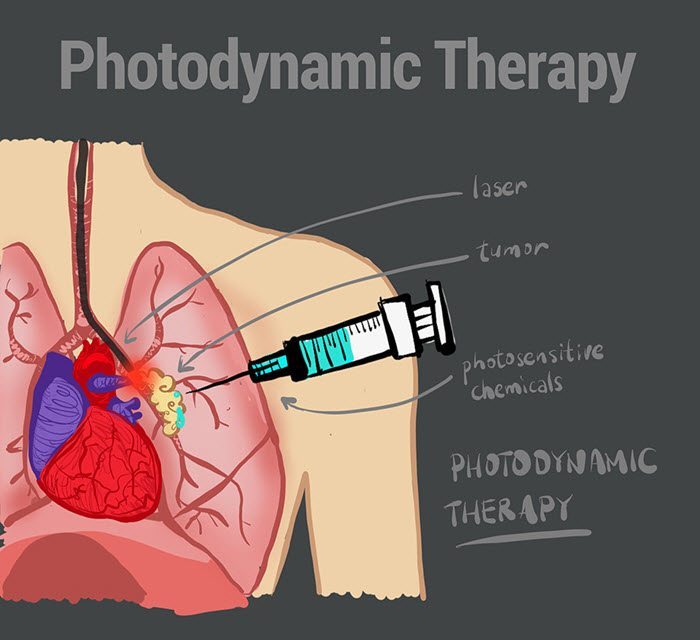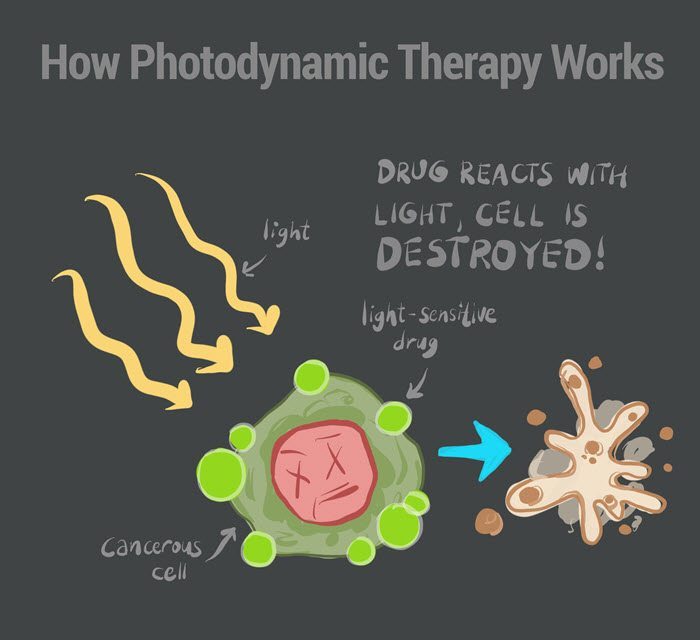Mesothelioma Photodynamic Therapy

Researchers are making steady progress in the search for new mesothelioma treatments, and photodynamic therapy (or PDT) has shown a lot of promise. This type of treatment involves a drug ─ referred to as a photosensitizer or photosensitizing agent ─ that is given to a patient intravenously, absorbed into the body and then activated by a special light. When activated, the drug produces a type of oxygen that kills the cells around it, specifically cancer cells.
What makes photodynamic therapy ─ also known as photoradiation therapy, phototherapy, or photochemotherapy ─ such a promising treatment option for mesothelioma, apart from its effectiveness, is its relatively mild side effects. Intraoperative photodynamic therapy, in particular, is being studied as a way to directly target mesothelioma while the patient is undergoing surgery.
Although it has not yet been approved by the FDA for mesothelioma treatment, the photosensitizing agent porfimer sodium (also known as Photofrin) has been approved to treat esophageal cancer and non-small cell lung cancer. Mesothelioma patients can currently explore PDT treatment options through clinical trials.
How Photodynamic Therapy (PDT) Works
Photodynamic therapy for mesothelioma is not a one-step process. In fact, the photosensitizer drug alone will not make a difference without the light to activate it. According to the National Cancer Institute, the PDT treatment process works like this:

- First, a photosensitizing agent is injected into the patient. For intraoperative photodynamic therapy, the agent is injected before surgery.
- The body’s cells absorb the agent, but the drug stays in cancer cells longer than it stays in the body’s normal cells.
- In 24 to 72 hours, depending on the agent used, most of the drug passes through the body’s normal cells but lingers in the cancer cells.
- At this point, the cancer cells are exposed to the special light. The stretch of time between when a patient receives the drug and when the light is applied is known as the drug-to-light interval.
- For intraoperative photodynamic therapy, the surgery is timed based on when the drug has left the normal cells. The surgeon first removes as much of the mesothelioma tumor as possible, then uses the light to activate the agent in any mesothelioma cancer cells that may have been left behind.
- The light, which is often from a laser, can also be delivered through fiber optic cables inserted into the patient’s body with an
- When the photosensitizing agent in the cancer cells is exposed to the light, it produces a form of oxygen that destroys the cells.
- When activated by the light, the agent can also damage blood vessels in a tumor, cutting it off from nutrients.
- In addition, PDT may trigger the immune system to attack the cancer cells, making it a possible combination treatment with immunotherapy for mesothelioma.
- Photodynamic therapy for mesothelioma may also be combined with radiation or chemotherapy.
Side Effects of Photodynamic Therapy for Mesothelioma
Compared to some of the other traditional treatments for mesothelioma, PDT has relatively minor side effects. The most prominent side effect is:
- Sensitivity to light ─ Patients must be careful from the moment they are given the photosensitizing agent. Your doctor will explain the special precautions you should take in the time between being given the drug and the time it will be activated with the laser. Your doctor will also take precautions during surgery to avoid exposing you to unnecessary light, and you will be advised of how to protect yourself from light sensitivity for about six weeks after the treatment.
Additional side effects include:
- Burns, swelling, pain and scarring in healthy tissues near the treatment site
- Coughing, painful breathing and shortness of breath
- Problems swallowing
- Abdominal pain
It is important that you talk to your doctor in-depth about the side effects of photodynamic therapy for mesothelioma so you are prepared for what to expect. As with any clinical trial, you should ask as many questions as you need to in order to feel comfortable receiving the treatment.
Pros and Cons of Photodynamic Therapy
When deciding whether to try PDT for mesothelioma, you will need to weigh the pros and cons. The American Cancer Society suggests patients take into consideration:
PROS
- PDT does not have long-term side effects.
- The treatment process usually takes only a short time.
- It is very targeted, causing less damage to nearby cells.
- It does not have a cumulative toxicity, so it can be repeated many times if needed.
- It generally costs less than some other treatments.
CONS
- PDT is limited by how far the light can reach. That’s why PDT for mesothelioma is currently combined with surgery.
- It can’t be used if the cancer has spread to many places.
- PDT drugs make people very sensitive to light, so precautions must be taken, including during surgery.
- PDT cannot be used in people with certain blood diseases such as porphyrias or people who are allergic to porphyrins.
How Is PDT for Mesothelioma Different?
Mesothelioma most often develops in the tissue lining the pleural and peritoneal cavities, as well as the tissue lining the lungs and abdominal organs. Intraoperative photodynamic therapy for mesothelioma could be ideal because the tissue lining these areas is relatively thin, and the light used to activate photosensitizing agents can only penetrate a short distance. This means that compared with other, more penetrating modes of treatment paired with surgery, PDT may do less damage to surrounding cells.
The Future of PDT for Mesothelioma
The search for a mesothelioma cure is ongoing, and many developments are being made to expand PDT treatments. The American Cancer Society points to promising studies that are exploring the future of PDT, including:
- New photosensitizing drugs that may treat tumors deeper under the skin or in body tissues
- Agents that may be more selective of cancer cells versus the body’s normal cells
- Drugs that may act more quickly to reduce the time needed before the light treatment
- Agents that may leave the body more quickly, reducing light-sensitivity side effects
- Different types of lasers and light sources that may improve treatment
- Agents that may respond to both radiation and light, allowing a reduction in the amount of radiation traditionally used
Finding a Photodynamic Therapy for Mesothelioma Clinical Trial
The possibilities for PDT treatment have given many mesothelioma patients hope for a better quality of life and extended life expectancy. PDT for mesothelioma clinical trials are paving the way for patients to test this option and potentially change the way this deadly cancer is treated.
Visit our Mesothelioma Research and Clinical Trials page to search for a PDT clinical trial. You can also contact mesothelioma specialist Joseph S. Friedberg, M.D., a thoracic surgeon who has pioneered the use of photodynamic therapy for mesothelioma treatment.
In addition, we encourage you to talk to other patients, caregivers and medical professionals about PDT by using our mesothelioma community resources. We know how hard the fight against mesothelioma can be, and having a strong support system in place can make all the difference.
Sources & Author:
- American Cancer Society: Photodynamic Therapy
- Annals of Cardiothoracic Surgery: Radical Pleurectomy and Photodynamic Therapy for Malignant Pleural Mesothelioma
- Expert Review of Respiratory Medicine: Photodynamic Therapy for Malignant Pleural Mesothelioma: The Future of Treatment?
- National Cancer Institute: Photodynamic Therapy for Cancer
